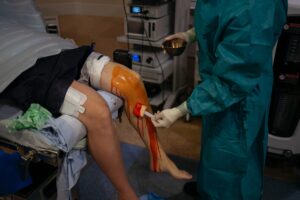Is Diabetic Wound Care Cream Worth Your While?

iShanCare® Diabetic Wound Ulcer Cream is typically used as a topical treatment to help promote the healing of diabetic ulcers, wounds, and skin lesions. It’s specifically formulated for people with diabetes, as they are more prone to developing chronic wounds or ulcers, particularly on their feet or legs, due to poor circulation and neuropathy. Here’s a general guide on how to use the cream, but always follow the instructions provided by your healthcare provider or the product label for the best results.
How to Use iShanCare® Diabetic Wound Ulcer Cream:
- Clean the Affected Area:
- Gently clean the wound or ulcer with mild soap and clean water. You may also use a wound cleanser recommended by your doctor.
- Pat the area dry with a clean towel or sterile gauze pad to prevent any irritation or infection.
- Apply the Cream:
- Take a small amount of iShanCare® Diabetic Wound Ulcer Cream and apply it directly to the affected area.
- Make sure to cover the ulcer or wound evenly with a thin layer of the cream. Avoid excessive application, as a little usually goes a long way.
- Massage Gently:
- Gently massage the cream into the skin around the wound, but avoid putting pressure on the actual ulcer or wound site.
- Ensure the cream is absorbed well, but do not rub vigorously.
- Cover the Wound (Optional):
- Depending on the severity of the wound and the advice of your healthcare provider, you may be asked to cover the wound with a sterile bandage or dressing after applying the cream.
- A dressing may help protect the wound, reduce the risk of infection, and keep the wound moist for optimal healing.
- Repeat the Application:
- Apply the cream as directed by your healthcare provider. This is typically done 1-2 times per day, but some individuals may need more frequent applications depending on the severity of the wound.
- If the wound shows signs of infection (increased redness, warmth, or drainage), consult your doctor immediately, as additional treatment may be needed.
- Monitor Progress:
- Keep an eye on the wound’s healing progress. If you notice any worsening symptoms or signs of infection (such as pus, bad odor, or increased pain), consult your healthcare provider.
- If there are no signs of improvement after a few weeks, further medical intervention may be necessary.
Additional Tips:
- Keep Blood Sugar Levels in Check: Since diabetes can affect the healing process, it’s essential to maintain good blood glucose control for optimal wound healing.
- Avoid Irritants: Do not apply the cream to any open wounds if they are excessively contaminated, as this might lead to irritation. Also, avoid using the cream near the eyes or mucous membranes.
- Consult Your Healthcare Provider: Always check with your healthcare provider before using a new topical treatment, especially if you have other underlying conditions or are using other medications.
Possible Side Effects:
While iShanCare® Diabetic Wound Ulcer Cream is generally safe for most people, if you experience any redness, itching, or irritation, discontinue use and consult your doctor. It is always important to do a patch test before applying a new product to larger areas of the body, especially for individuals with sensitive skin.
Conclusion:
iShanCare® Diabetic Wound Ulcer Cream can be a valuable addition to the wound care routine for people with diabetes, helping to support faster healing of diabetic ulcers and skin wounds. However, proper hygiene and monitoring are crucial for ensuring the effectiveness of the treatment and preventing complications. Always consult with a healthcare provider to tailor the treatment to your specific needs.

